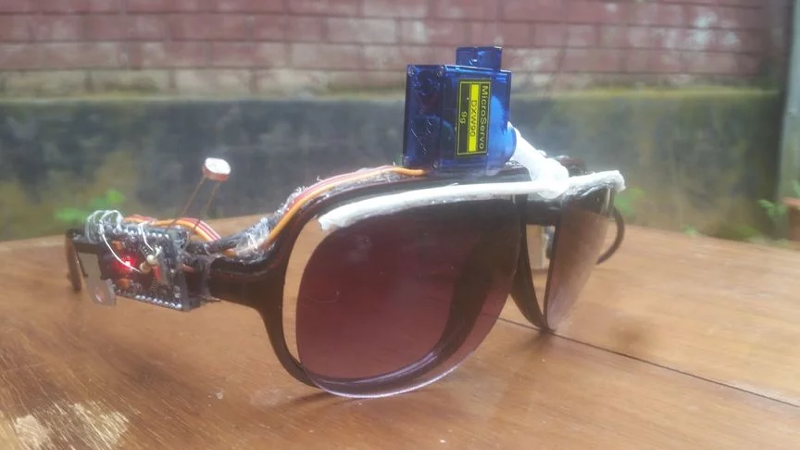These days, photochromic lenses are old-hat. Sure, it’s useful to have a pair of glasses that automatically tints due to UV light, but what if you want something a little more complex and flashy? Enter [Ashraf Minhaj]’s SunGlass-Bot.
The build is simple, beginning with an Arduino Pro Mini for reasons of size. Connected to the analog input is a light-dependent resistor for sensing the ambient light level. This reading is then used to decide whether or not to move the servo which controls the position of the lenses. In low light, the lenses are flipped up to allow clear vision; in brighter light, the lenses flip down to protect the eyes. Power is supplied by a homebrew powerbank that it appears [Ashraf] built from an old phone battery and a small boost converter board. All the files to recreate the project are available on Github, too.
It’s a fun build that [Ashraf] shows off in style. While this may not be as effortless as a set of Transition lenses or as quick as a welding mask filter, it has a certain mechanical charm that wouldn’t be out-of-place in a certain sci-fi aesthetic.
Hungry for more? Check out these self-blending sunglasses we featured a while back. Video after the break.
















We live in a great time and age, where it is easier to program a computer doing lot’s of difficult stuff with greater easy then combining a simple motor with a few transistors and a set of limit switches.
But this is certainly a hack, a simple device (sunglasses) now had extra functionality.
Yet I wonder how heavy this things is and how long you are able to carry it around on your nose.
Sure it feels okay for a minute but an hour could result in pain during the constant pressure on your nose as for glasses count that every gram matters. But I looks silly and made me laugh, so I would say: a project well done.
WOW! You almost can’t see the carefully integrated hardware that makes this such a technically advanced must-have item. Almost.
But you can see the fun he had in building a goofy project, right?
Is this based on the same tech as shutter glasses?
A UV filter is *required* if so, you don’t want to be hassled by lawyers when people have nuclear cataracts in a few years.
Have you watched the video ?
Oh, Brother, why do you say “A UV filter is *required*…”? Does plastic on one’s nose confer increased sensitivity to UV light to one’s cornea? Are modern eyeballs more sensitive than, say, my grandfather’s? Is there much more UV in anthropocene sunlight? Are there excessively predatory lawyers around? Or is this just FUD with roots in ignorance?
No guff about “retinas are sensitive to UV” either: No UV gets through to the retina in normal eyes.
(besides, they’re *plastic* lenses. Essentially all plastics block UV light.)
https://media.giphy.com/media/cTw8V1RMKo3Bu/source.gif
Glasses like this are a fun way of getting kids excited about simple robots. A couple of kids at our UNH summer programming camp made them earlier this summer. We used Circuit Playgrounds from Adafruit that have a built in light sensor but the concept is the same. As a bonus, the Circuit Playground has 10 Neopixels so the glasses also could light up white in a dark space to help you see. Yes, any of these designs are awkward but it’s still instructive to see how to design a system that does real work in response to external conditions. In past years I’ve seen it done with Ardweenys and other small Arduino forms too. For kids that don’t get excited about robots with wheels and arms, these are great. Kudos to Ashraf for a great implementation.
Didn’t expect to see an article about a project like this.
Ben Heck did it years ago and there’s countless other projects basically the same.
It was one of the first things I did starting with Arduino.
There are lovely linear servos used in ultralight RC helicopters. They would work perfectly here and could almost be hidden.
He’ll soon be facing a preemptive copyright infringement lawsuit from the makers of the Joo Janta 200 Super-Chromatic Peril Sensitive Sunglasses.
https://hitchhikers.wikia.com/wiki/Joo_Janta_200_Super-Chromatic_Peril_Sensitive_Sunglasses